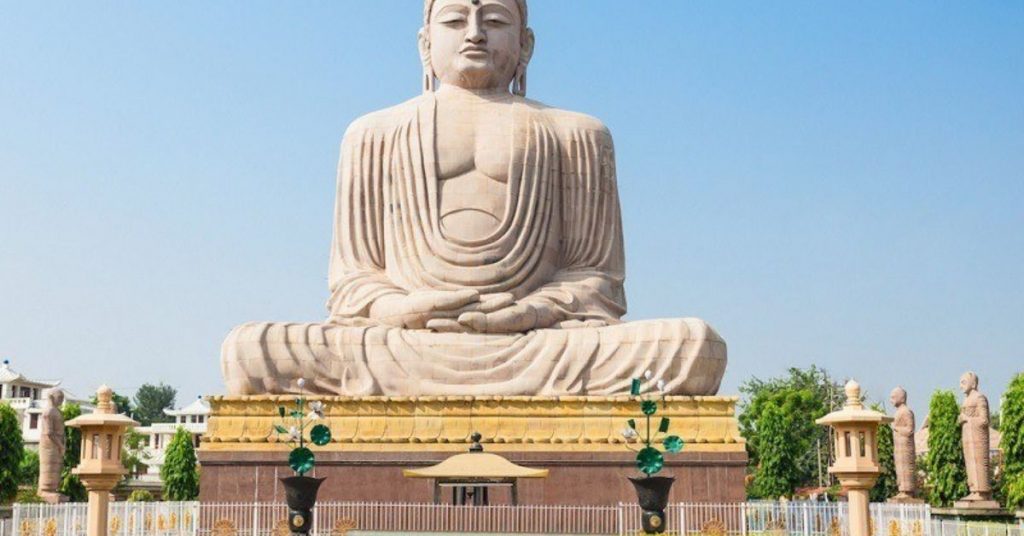Discover the spiritual Importance of Bodhgaya in Buddhism, the sacred site where Lord Buddha attained enlightenment under the Bodhi tree. Learn why it’s a key pilgrimage destination for Buddhists worldwide.
Bodhgaya, located in the Indian state of Bihar, holds unparalleled importance in the Buddhist world. It is the sacred site where Siddhartha Gautama attained enlightenment under the Bodhi Tree, thereby becoming the Buddha, or “The Awakened One.” Every aspect of this holy town—its temples, stupas, monasteries, and sacred spots—resonates with the essence of spiritual awakening, compassion, and mindfulness. This historical overview offers a comprehensive understanding of Bodhgaya’s role in shaping Buddhism from its origins to the modern era.
Contents
- 1 The Enlightenment of the Buddha: Bodhgaya’s Eternal Legacy
- 2 The Mahabodhi Temple: A Monument to Enlightenment
- 3 Emperor Ashoka’s Pilgrimage and Patronage
- 4 Monastic Universities and Scholarly Contributions
- 5 Invasions and Decline: The Lost Glory
- 6 Colonial Rediscovery and Revival
- 7 Modern-Day Bodhgaya: A Global Pilgrimage Destination
- 8 Bodhgaya in the Global Buddhist Consciousness
- 9 Conclusion: The Eternal Light of Awakening
Importance of Bodhgaya in Buddhism

The Enlightenment of the Buddha: Bodhgaya’s Eternal Legacy
In the 6th century BCE, a young prince named Siddhartha Gautama, disillusioned with worldly life, left his royal palace in search of the ultimate truth. After years of ascetic practices and wandering, he arrived at Uruvela (ancient Bodhgaya) and sat in deep meditation beneath a sacred fig tree (Ficus religiosa).
After meditating for 49 days, he attained enlightenment, realizing the Four Noble Truths and the Eightfold Path, which became the foundation of Buddhism. The tree became the Bodhi Tree, and the location was henceforth known as Bodhgaya, meaning “Place of Awakening.”
The Mahabodhi Temple: A Monument to Enlightenment
The Mahabodhi Temple, now a UNESCO World Heritage Site, was originally built by Emperor Ashoka the Great in the 3rd century BCE. Ashoka, a devout follower of Buddhism after the Kalinga war, visited Bodhgaya to honor the Buddha’s enlightenment & Importance of Bodhgaya in Buddhism.
Key Highlights of the Mahabodhi Temple Complex:
- Vajrasana (Diamond Throne): The precise location where Buddha meditated.
- The Bodhi Tree: A direct descendant of the original tree.
- Meditation Sites: Seven sacred spots marking the Buddha’s journey post-enlightenment.
- Ashokan Pillar and Buddhist Reliefs: Bearing inscriptions that detail historical pilgrimages.
Importance of Bodhgaya in Buddhism : The temple has stood as a beacon of devotion and pilgrimage for centuries and is one of the most visited Buddhist sites in the world.
Emperor Ashoka’s Pilgrimage and Patronage
Emperor Ashoka’s visit to Bodhgaya around 260 BCE marked a major turning point in its history. Deeply influenced by the Dhamma (teachings of Buddha), he not only constructed the first temple at the site but also installed pillars, railings, and stupas across India to spread Buddhist philosophy.
His actions made Bodhgaya a center of global Buddhist worship, attracting monks, scholars, and pilgrims from across Asia, especially from Sri Lanka, Tibet, China, Japan, Thailand, and Myanmar & Importance of Bodhgaya in Buddhism.
Monastic Universities and Scholarly Contributions
Between the 5th and 12th centuries, Bodhgaya, along with nearby Nalanda and Vikramshila, became a thriving hub of Buddhist scholarship. Monks from Bodhgaya played a pivotal role in developing and disseminating:
- Mahayana and Vajrayana texts
- Meditation practices
- Buddhist logic and metaphysics
Renowned scholars like Atisha Dipankara, Xuanzang, and Faxian documented their travels to Bodhgaya, providing vivid accounts of its spiritual grandeur and intellectual richness.
Invasions and Decline: The Lost Glory
With the invasions of the 12th century, particularly by Turkic forces, Bodhgaya saw significant destruction of temples and monasteries, leading to the decline of Buddhism in India. Many monks migrated eastward, helping establish Buddhism in Tibet, Nepal, and Southeast Asia.
The Mahabodhi Temple was neglected, and the site fell into obscurity, although Buddhist pilgrims from abroad continued to visit the region discreetly.
Colonial Rediscovery and Revival
During British rule in the 19th century, archaeologists like Alexander Cunningham and Joseph Beglar rediscovered and documented the ruins of Bodhgaya. The temple was gradually restored, and interest in Buddhism resurged.
In 1891, Anagarika Dharmapala, a Sri Lankan Buddhist reformer, established the Mahabodhi Society and initiated a global movement to reclaim and restore Bodhgaya for Buddhists.
Key Events of the Revival Era:
- Restoration of the Mahabodhi Temple.
- Legal disputes for control resolved in favor of joint Hindu-Buddhist management.
- Renewed pilgrimages from Sri Lanka, Burma, Japan, and Tibet.
Modern-Day Bodhgaya: A Global Pilgrimage Destination
Today, Bodhgaya is a vibrant spiritual and cultural epicenter, attracting millions of visitors every year. It represents a living symbol of peace, compassion, and universal brotherhood.
Modern Highlights:
- Annual International Buddhist Conventions
- Teachings and empowerments by the Dalai Lama
- Global Monasteries: Countries like Thailand, Bhutan, Vietnam, Japan, China, and others have established their own temples here.
- Meditation Retreats and Vipassana Courses at world-renowned centers like Root Institute, Tergar Monastery, and Dhamma Bodhi Vipassana Center.
Bodhgaya also plays a pivotal role in interfaith dialogue, cultural diplomacy, and spiritual tourism in the 21st century.
Bodhgaya in the Global Buddhist Consciousness
Bodhgaya is not just a sacred site but a symbol of the core tenets of Buddhism—compassion, mindfulness, self-realization, and peace. It holds spiritual significance for all Buddhist traditions—Theravāda, Mahāyāna, and Vajrayāna—uniting diverse lineages through the shared memory of the Buddha’s awakening.
The pilgrimages to Bodhgaya, chanting under the Bodhi Tree, circumambulating the Mahabodhi Temple, and meditating in the same space where Buddha once sat—all become transformative acts that reaffirm the timeless relevance of Buddhist teachings.
Conclusion: The Eternal Light of Awakening
From its sacred beginnings under the Bodhi Tree to its role as a modern spiritual nucleus, Bodhgaya continues to inspire millions on the path of awakening. It is a place where time stands still, and the seeker connects with the eternal wisdom of the Enlightened One.
Whether you’re a pilgrim, a history lover, or a curious traveler, a visit to Bodhgaya offers not just historical knowledge, but an opportunity to experience the profound silence and spiritual clarity that once transformed a prince into the Buddha.





